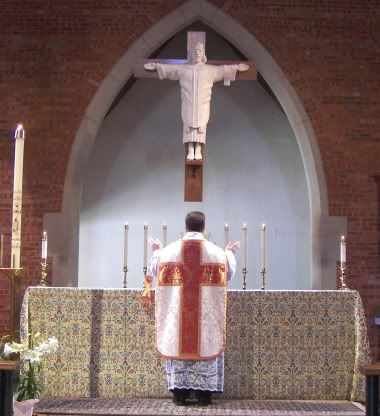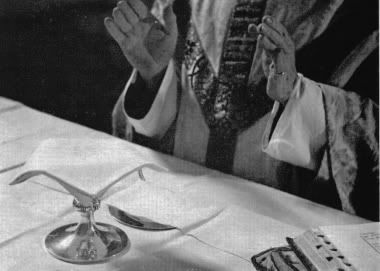
From the eucharistic prayer of the American Prayer Book:
"Wherefore, O Lord and heavenly Father, according to the institution of thy dearly beloved Son our Savior Jesus Christ, we, thy humble servants, do celebrate and make here before thy divine Majesty, with these thy holy gifts, which we now offer unto thee, the memorial thy Son hath commanded us to make; having in remembrance his blessed passion and precious death, his mighty resurrection and glorious ascension; rendering unto thee most hearty thanks for the innumerable benefits procured unto us by the same."
William Forbes (1585-1634), the Anglican Bishop of Edinburgh and professor at Aberdeen University, wrote in his work Considerationes Modestate et Pacificae ("Modest, Peacemaking Considerations"):
"The holy Fathers say very often that in the Eucharist Christ's Body itself is offered and sacrificed, as appears from almost numberless places, but so, that not all the properties of a sacrifice are properly and really preserved; but by way of commemoration and representation of that which was performed once for all in that one only Sacrifice of the Cross, whereby Christ our High Priest consummated all other sacrifices, and by pious prayer; by which the ministers of the Church most humbly beseech God the father on account of the perpetual Victim of that one only Sacrifice, Which is seated in heaven on the right hand of the Father, and in an ineffable manner present on the holy table, that He would grant that the virtue and grace of this perpetual Victim may be efficacious and salutary to His Church for all the necessities of body and soul."
He went on to say: "The sacrifice which is performed in the Supper is not merely Eucharistic, but also in a sound sense propitiatory, and is profitable not only to very many of the living, but of the departed also."
Thomas Rattray (1684-1743), another Anglican bishop in the Scottish Episcopal Church, in his posthumous work, Some Particular Instructions Concerning the Christian Covenant and the Mysteries by which it is Transacted and Maintained (1748), wrote as follows:
"Then as Christ offered up His body and blood to God the Father under the symbols of bread and wine as a sacrifice to be slain on the cross for our redemption, so here the priest offereth up this bread and cup as the symbols of this sacrifice of His body and blood thus once offered up by Him, and thereby commemorateth it before God with thanksgiving; after which He prays that God would favourably accept this commemorative sacrifice by sending down upon it His Holy Spirit, that by His descent upon them He may make this bread and this cup ... as to be symbols or antitypes of the body and blood of Christ ... Then the priest maketh intercession in virtue of this sacrifice thus offered up in commemoration of, and in union with, the one great personal sacrifice of Christ, for the whole Catholic Church, and pleadeth the merits of this one sacrifice in behalf of all estates and conditions of men in it, offering this memorial thereof not for the living only but for the dead also, in commemoration of the Patriarchs, Prophets, Apostles, Martyrs, and of all the saints who have pleased God in their several generations from the beginning of the world; and for the rest, light, and peace, and a blessed resurrection, and a merciful trial in the day of the Lord to all the faithful departed."



2 comments:
Keep those elbows in, Father. It looks like your hands are outside the width of the corporal.
Those aren't mine, but I don't believe in staying in the batter's box. It makes it look like you are trying to catch something or waiting to stangle someone.
Post a Comment